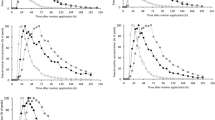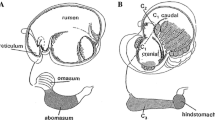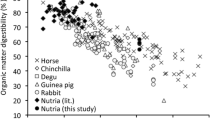Abstract
In contrast to the domestic horse, whose digestive physiology has been thoroughly investigated, knowledge on the digestive physiology of wild equids is scarce. Comparisons between the domestic horse and the domestic donkey suggest that wild asses might achieve higher digestibilities. This could derive from longer retention times or a greater difference in the mean retention time (MRT) of particles vs. fluid (the selectivity factor (SF)). Here, we measured MRT of a solute (fluid; MRTsolute) and a particle (<2 mm; MRTparticle) marker in five captive male Somali wild asses (Equus africanus somaliensis) fed a diet of 95% grass hay. At a mean dry matter intake of 94 ± 3 g kg−0.75 day−1, MRTsolute was 33.3 ± 5.4 h and MRTparticle 39.6 ± 3.9 h, resulting in a SF of 1.21 ± 0.14. For their food intake, Somali wild asses appeared to have slightly higher MRTparticle than expected based on domestic equid data, in contrast to Grevy zebras (Equus grevyi), potentially indicating higher capacities of the digestive tract. However, considering data on domestic horses, donkeys, and zebra, there was no evident difference in the SF of wild equids compared to domestic ones. Together with an absence of reported anatomical differences in the digestive tract of wild and domestic equids, the data suggest a general similarity in the digestive physiology of equid species that contrasts with the diversity in the digestive physiology of ruminants, and that might be one contributing factor to a lack of sympatric, niche-differentiated equid species.


Similar content being viewed by others
References
Alberdi MT, Prado J, Ortiz-Jaureguizar E (1995) Patterns of body size changes in fossil and living equini (Perissodacytla). Biol J Linn Soc 4:349–370
Austbø D, Volden H (2006) Influence of passage model and caecal cannulation on estimated passage kinetics of roughage and concentrate in the gastrointestinal tract of horses. Livestock Sci 100:33–43
Clauss M, Hume ID, Hummel J (2010a) Evolutionary adaptations of ruminants and their potential relevance for modern production systems. Animal 4:979–992
Clauss M, Hummel J, Schwarm A, Steuer P, Fritz J, Martin Jurado O, Tschudin A, Hatt J-M (2008) An isthmus at the caecocolical junction is an anatomical feature of domestic and wild equids. Eur J Wildl Res 54:347–351
Clauss M, Lang-Deuerling S, Müller DWH, Kienzle E, Steuer P, Hummel J (2010b) Retention of fluid and particles in captive tapirs (Tapirus spp.) Comp Biochem Physiol A 157:95–101
Clauss M, Steuer P, Müller DWH, Codron D, Hummel J (2013) Herbivory and body size: allometries of diet quality and gastrointestinal physiology, and implications for herbivore ecology and dinosaur gigantism. PloS One 8:e68714
Clauss M, Schiele K, Ortmann S, Fritz J, Codron D, Hummel J, Kienzle E (2014) The effect of very low food intake on digestive physiology and forage digestibility in horses. J Anim Physiol Anim Nutr 98:107–118
Cuddeford D, Pearson RA, Archibald RF, Muirhead RH (1995) Digestibility and gastro-intestinal transit time of diets containing different proportions of alfalfa and oat straw given to Throroughbreds, Shetland ponies, Highland ponies and donkeys. Anim Sci 61:407–417
de Araújo Oliveira CA, de Almeida FQ, Vieira AA, Quintão Lana AM, Macedo R, Adese Lopes B, Corassa A (2003) Kinetics of passage of digesta and water and nitrogen balance in horses fed diets with different ratios of roughage and concentrate. Rev Bras Zootec 32:140–149
Dittmann MT, Hummel J, Hammer S, Arif A, Hebel C, Müller DWH, Fritz J, Steuer P, Schwarm A, Kreuzer M, Clauss M (2015) Digesta retention in gazelles in comparison to other ruminants: evidence for taxon-specific rumen fluid throughput to adjust digesta washing to the natural diet. Comp Biochem Physiol A 185:58–68
Drogoul C, de Fombelle A, Julliand V (2001) Feeding and microbial disorders in horses. II. Effect of three hay:grain ratios on digesta passage rate and digestibility in ponies. J Equine Vet Sci 21:487–491
Drogoul C, Poncet C, Tisserand JL (2000) Feeding ground and pelleted hay rather than chopped hay to ponies. I. Consequences for in vivo digestibility and rate of passage of digesta. Anim Feed Sci Technol 87:117–130
Earing JE, Lawrence LM, Hayes SH, Brummer M, Vanzant E (2013) Digestive capacity in weanling and mature horses. J Anim Sci 91:2151–2157
Ellis AD, Hill J (2005) Nutritional physiology of the horse. Nottingham University Press, Nottingham
Evans AR, Janis CM (2014) The evolution of high dental complexity in the horse lineage. Ann Zool Fenn 51:73–79
Foose TJ (1982) Trophic strategies of ruminant versus nonruminant ungulates . University of Chicago, Chicago, PhD Thesis
Forsten A (1989) Horse diversity through the ages. Biol Rev 64:279–304
Goachet AG, Varloud M, Philippeau C, Julliand V (2010) Long-term effects of endurance training on total tract apparent digestibility, total mean retention time and faecal microbial ecosystem in competing Arabian horses. Equine Vet J 42:387–392
Hofmann RR (1989) Evolutionary steps of ecophysiological adaptation and diversification of ruminants: a comparative view of their digestive system. Oecologia 78:443–457
Hummel J, Clauss M, Zimmermann W, Johanson K, Norgaard C, Pfeffer E (2005) Fluid and particle retention in captive okapi (Okapia johnstoni). Comp Biochem Physiol A 140:436–444
Hummel J, Hammer S, Hammer C, Ruf J, Lechenne M, Clauss M (2015) Solute and particle retention in a small grazing antelope, the blackbuck (Antilope cervicapra). Comp Biochem Physiol A 182:22–26
Izraely H, Chosniak I, Stevens CE, Demment MW, Shkolnik A (1989) Factors determining the digestive efficiency of the domesticated donkey (Equus asinus asinus). Quart J Exp Physiol 74:1–6
Janis CM, Gordon IJ, Illius AW (1994) Modelling equid/ruminant competition in the fossil record. Hist Biol 8:15–29
Jerbi H, Rejeb A, Erdoğan S, Pérez W (2014) Anatomical and morphometric study of gastrointestinal tract of donkey (Equus africanus asinus). J Morphol Sci 31:18–22
Juliand V, Tisserand JL, Michalet-Doreau B, Fonty G (1997) In situ degradation of two forages by the ruminal ecosystem of bovines and the caecal ecosystem of equidae. J Anim Sci 75(Supp. 1):266
Jumars PA (2000) Animal guts as nonideal chemical reactors: partial mixing and axial variation in absorption kinetics. Am Nat 155:544–555
Kaczensky P, Ganbaatar O, Von Wehrden H, Walzer C (2008) Resource selection by sympatric wild equids in the Mongolian Gobi. J Appl Ecol 45:1762–1769
Kasirer-Izraely H, Choshniak I, Shkolnik A (1993) Dehydration and rehydration in donkeys: the role of the hind gut as a water reservoir. J Basic Clin Physiol Pharmacol 5:89–100
Kobayashi Y, Koike S, Miyaji M, Hata H, Tanaka K (2006) Hindgut microbes, fermentation and their seasonal variations on hokkaido native horses compared to light horses. Ecol Res 21:285–291
Maloiy GMO, Taylor CR, Clemens ET (1978) A comparison of gastrointestinal water content and osmolality in East African herbivores during hydration and dehydration. J Agric Sci 91:249–254
Meyer K, Hummel J, Clauss M (2010) The relationship between forage cell wall content and voluntary food intake in mammalian herbivores. Mammal Rev 40:221–245
Miyaji M, Ueda K, Hata H, Kondo S (2011) Effects of quality and physical form of hay on mean retention time of digesta and total tract digestibility in horses. Anim Feed Sci Technol 165:61–67
Miyaji M, Ueda K, Hata H, Kondo S (2014) Effect of grass hay intake on fiber digestion and digesta retention time in the hindgut of horses. J Anim Sci 92:1574–1581
Moore-Colyer MJS, Morrow HJ, Longland AC (2003) Mathematical modelling of digesta passage rate, mean retention time and in vivo apparent digestibility of two different lengths of hay and big-bale grass silage in ponies. Br J Nutr 90:109–118
Moreira Pimentel RR, Queiroz de Almeida F, Assis Vieira A, Pessim de Oliveira AP, Nascimento de Godoi F, Biazon França A (2009) Consumo, digestibilidade aparente dos nutrientes e balanço hídrico em equinos alimentados com feno de coast-cross em diferentes formas. Rev Bras Zootec 38:1272–1278
Müller DWH, Caton J, Codron D, Schwarm A, Lentle R, Streich WJ, Hummel J, Clauss M (2011) Phylogenetic constraints on digesta separation: variation in fluid throughput in the digestive tract in mammalian herbivores. Comp Biochem Physiol A 160:207–220
NACLAR (2004) National Advisory Committee for Laboratory Animal Research: Guidelines on the care and use of animals for scientific purposes. NACLAR, Singapore
Nickel R, Schummer A, Seiferle E (2004) Lehrbuch der Anatomie der Säugetiere, vol 2. Parey Verlag, Stuttgart
Orton RK, Hume ID, Leng RA (1985a) Effect of exercise and level of dietary protein on digestive function in horses. Equine Vet J 17:386–390
Orton RK, Hume ID, Leng RA (1985b) Effect of level of dietary protein and exercise on growth rates of horses. Equine Vet J 17:381–385
Pagan JD, Harris P, Brewster-Barnes T, Duren SE, Jackson SG (1998) Exercise affects digestibility and rate of passage of all-forage and mixed diets in thoroughbred horses. J Nutr 128:2704S–2707S
Pearson RA, Archibald RF, Muirhead RH (2001) The effect of forage quality and level of feeding on digestibility and gastrointestinal transit time of oat straw and alfalfa given to ponies and donkeys. Br J Nutr 85:599–606
Pearson RA, Archibald RF, Muirhead RH (2006) A comparison of the effect of forge type and level of feeding on the digestibility and gastrointestinal mean retention time of dry forages given to cattle, sheep, ponies and donkeys. Br J Nutr 95:88–98
Pearson RA, Cuddeford D, Archibald RF, Muirhead RH (1992) Digestibility of diets containing different proportions of alfalfa and oat straw in thoroughbreds, Shetland ponies, Highland ponies and donkeys. Pferdeheilkd Special Issue 1:153–157
Pearson RA, Merritt JB (1991) Intake, digestion and gastrointestinal transit time in resting donkeys and ponies and exercised donkeys given ad libitum hay and straw diets. Equine Vet J 23:339–343
Pimentel Silva V, Queiroz de Almeida F, Moreira Pimentel RR, Nascimento de Godoi F, Marques dos Santos T, Sandes Pires M (2014) Passage kinetics of digesta in horses fed with coastcross hay ground to different degrees. Ciênc Agrotec 38:506–514
Rosenfeld I, Austbø D, Volden H (2006) Models for estimating digesta passage kinetics in the gastrointestinal tract of the horse. J Anim Sci 84:3321–3328
Sneddon JC, Boomker E, Howard CV (2006) Mucosal surface area and fermentation activity in the hind gut of hydrated and chronically dehydrated working donkeys. J Anim Sci 84:119–124
Steuer P, Clauss M, Südekum K-H, Hatt J-M, Silinski S, Klomburg S, Zimmermann W, Fickel J, Streich WJ, Hummel J (2010) Comparative investigations on digestion in grazing (Ceratotherium simum) and browsing (Diceros bicornis) rhinoceroses. Comp Biochem Physiol A 156:380–388
Steuer P, Südekum K-H, Müller DWH, Franz R, Kaandorp J, Clauss M, Hummel J (2011) Is there an influence of body mass on digesta mean retention time in herbivores? A comparative study on ungulates. Comp Biochem Physiol A 160:355–364
Suhartanto B, Julliand V, Faurie F, Tisserand JL (1992) Comparison of digestion in donkeys and ponies. Pferdeheilkd 1st European Conference on Equine Nutrition:158–161
Thielemans MF, Francois E, Bodart C, Thewis A (1978) Mesure du transit gastrointestinal chez le porc a l'aide des radiolanthanides. Comparaison avec le mouton. Ann Biol Anim Biochim Biophys 18:237–247
Tisserand JL, Faurie F, Toure M (1991) A comparative study of donkey and pony digestive physiology. In: Fielding D, Pearson RA (eds) Donkeys, mules and horses in tropical agricultural development. Centre for Tropical Veterinary Medicine, University of Edinburgh, Edinburgh, pp 67–72
Todd LK, Sauer WC, Christopherson RJ, Coleman RJ, Caine WR (1995) The effect of level of feed intake on nutrient and energy digestibilities and rate of feed passage in horses. J Anim Physiol Anim Nutr 73:140–148
Udén P, Colucci PE, Van Soest PJ (1980) Investigation of chromium, cerium and cobalt as markers in digesta. Rate of passage studies. J Sci Food Agric 31:625–632
Van Weyenberg S, Sales J, Janssens GPJ (2006) Passage rate of digesta through the equine gastrointestinal tract: a review. Livestock Sci 99:3–12
Wolter R, Durix A, Letourneau JC (1976) Influence du mode de présentation d'un aliment complet sur la vitesse du transit digestif et la digestibilité chez le poney. Ann Zootech 25:181–188
Yoder MJ, Miller EH, Rook J, Shelle JE, Ullrey DE (1997) Fiber level and form: effects on digestibility, digesta flow and incidence of gastrointestinal disorders. Proceedings of the 15th Equine Nutrition and Physiology Symposium, Ft Worth, Texas:122–127
Zhang Y, Cao QS, Rubenstein DI, Zang S, Songer M, Leimgruber P, Chu H, Cao J, Li K, Hu D (2015) Water use patterns of sympatric Przewalski’s horse and khulan: interspecific comparison reveals niche differences. PLoS One 10:e0132094
Acknowledgements
This study was possible due to the kindness of the late HE Sheikh Saoud Bin Mohammed Al-Thani and his continuous support of scientific work and of the Zoo Research Camps. We thank F. Bach, R. Deiss, B. Dünner, T. Imboden, N. Kuster, A. Michel and D. Szabo for support in faecal sampling during ZRC 2009.
Author information
Authors and Affiliations
Corresponding author
Rights and permissions
About this article
Cite this article
Hummel, J., Hammer, C., Hammer, S. et al. Retention of solute and particle markers in the digestive tract of captive Somali wild asses (Equus africanus somaliensis). Eur J Wildl Res 63, 41 (2017). https://doi.org/10.1007/s10344-017-1098-1
Received:
Revised:
Accepted:
Published:
DOI: https://doi.org/10.1007/s10344-017-1098-1




